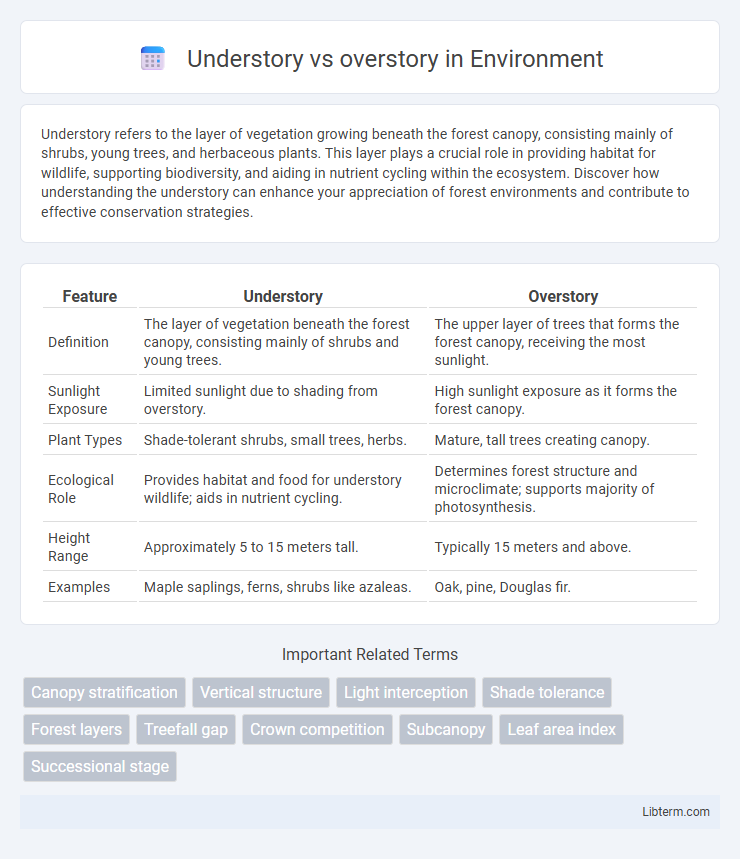Understory refers to the layer of vegetation growing beneath the forest canopy, consisting mainly of shrubs, young trees, and herbaceous plants. This layer plays a crucial role in providing habitat for wildlife, supporting biodiversity, and aiding in nutrient cycling within the ecosystem. Discover how understanding the understory can enhance your appreciation of forest environments and contribute to effective conservation strategies.
Table of Comparison
| Feature | Understory | Overstory |
|---|---|---|
| Definition | The layer of vegetation beneath the forest canopy, consisting mainly of shrubs and young trees. | The upper layer of trees that forms the forest canopy, receiving the most sunlight. |
| Sunlight Exposure | Limited sunlight due to shading from overstory. | High sunlight exposure as it forms the forest canopy. |
| Plant Types | Shade-tolerant shrubs, small trees, herbs. | Mature, tall trees creating canopy. |
| Ecological Role | Provides habitat and food for understory wildlife; aids in nutrient cycling. | Determines forest structure and microclimate; supports majority of photosynthesis. |
| Height Range | Approximately 5 to 15 meters tall. | Typically 15 meters and above. |
| Examples | Maple saplings, ferns, shrubs like azaleas. | Oak, pine, Douglas fir. |
Understanding Forest Layers: Overstory vs Understory
The overstory comprises the tallest trees forming the forest canopy, playing a crucial role in regulating sunlight, temperature, and moisture levels within the ecosystem. The understory consists of smaller trees, shrubs, and young saplings growing beneath the canopy, adapted to lower light conditions and supporting biodiversity by providing habitat for various species. Understanding the distinct functions and interactions of overstory and understory layers is essential for forest management, conservation, and assessing ecosystem health.
Defining Overstory and Understory in Ecosystems
Overstory refers to the upper layer of a forest composed of mature trees that dominate the canopy and control light penetration, temperature, and moisture levels beneath. Understory consists of smaller trees, shrubs, and plants growing beneath the overstory layer, adapting to lower light conditions and playing a crucial role in nutrient cycling and habitat diversity. This structural differentiation supports biodiversity and ecosystem stability by creating varied microenvironments within forest ecosystems.
Structural Differences Between Overstory and Understory
The overstory consists of the tallest trees forming the canopy layer, characterized by thick trunks, expansive crown spread, and high leaf area index that intercepts most sunlight. In contrast, the understory comprises shorter, shade-tolerant vegetation with slender stems and smaller leaves adapted to lower light conditions beneath the canopy. Structural differences influence microclimate and biodiversity, with overstory trees providing vertical habitat complexity and the understory supporting diverse ground-level plant and animal communities.
Key Species Found in Overstory and Understory
Key species found in the overstory include tall, mature trees such as oak, maple, and pine, which form the forest canopy and play a crucial role in regulating light and microclimate. The understory consists of smaller trees and shrubs like dogwood, holly, and saplings of overstory species, adapted to lower light conditions and contributing to forest regeneration. These distinct layers support diverse wildlife habitats and maintain ecosystem stability by promoting species richness and vertical stratification.
Ecological Roles of Overstory vs Understory Plants
Overstory plants primarily drive photosynthesis and carbon sequestration in forest ecosystems, shaping microclimates and providing crucial habitat and food resources for wildlife. Understory plants contribute to biodiversity by supporting nutrient cycling, soil stabilization, and offering shelter and foraging opportunities for ground-dwelling species. The dynamic interplay between overstory and understory vegetation maintains ecosystem resilience, promoting forest regeneration and ecological balance.
Light Availability: How it Shapes Overstory and Understory
Light availability plays a crucial role in shaping the structure and composition of overstory and understory vegetation in forest ecosystems. The overstory, composed of taller, canopy-forming trees, intercepts most sunlight, creating shaded conditions beneath that limit light penetration to the understory. This differential light distribution influences understory plant adaptations, favoring shade-tolerant species that optimize photosynthesis under low-light conditions and driving diversity patterns within the forest vertical layers.
Biodiversity Comparison: Overstory vs Understory
The understory hosts a diverse array of shade-tolerant plant species, contributing significantly to forest biodiversity by providing habitat and food resources for numerous insects, birds, and mammals. The overstory, composed of taller, canopy-forming trees, primarily supports biodiversity through large-scale photosynthesis and microclimate regulation, influencing the entire ecosystem structure. Biodiversity in the understory is often higher in species richness and density due to the variety of niches created by varying light and moisture conditions beneath the overstory canopy.
Growth Patterns in Overstory versus Understory
Overstory trees exhibit vertical growth characterized by tall trunks and expansive canopies to capture maximum sunlight, while understory plants adapt with slower, horizontal growth and larger leaves to thrive in shaded conditions. Overstory species prioritize rapid height to outcompete neighbors for light; understory species develop shade tolerance and broader leaves to optimize photosynthesis under filtered light. These distinct growth patterns reflect ecological adaptations that enable cohabitation within forest stratification and resource partitioning.
Human Impact on Overstory and Understory Dynamics
Human activities such as urban development, logging, and agriculture significantly alter overstory composition by reducing mature tree cover, which in turn affects understory microclimates and species diversity. Overstory changes influence light availability, soil moisture, and nutrient cycling, directly impacting understory plant growth, regeneration, and biodiversity. Restoration efforts targeting overstory structure can enhance understory resilience, promoting ecosystem stability and improving carbon sequestration in forested landscapes.
Conservation Strategies for Overstory and Understory Preservation
Overstory preservation involves maintaining mature canopy trees that regulate microclimate, support biodiversity, and prevent soil erosion, while understory conservation focuses on protecting shade-tolerant shrubs, ferns, and seedlings crucial for forest regeneration. Effective conservation strategies include selective logging to minimize canopy disruption, promoting native understory species through controlled burns or invasive species removal, and ensuring habitat connectivity to support species reliant on multi-layered forest structures. Sustained monitoring and integrating both overstory and understory dynamics in forest management plans optimize ecosystem resilience and biodiversity conservation.
Understory Infographic

 libterm.com
libterm.com